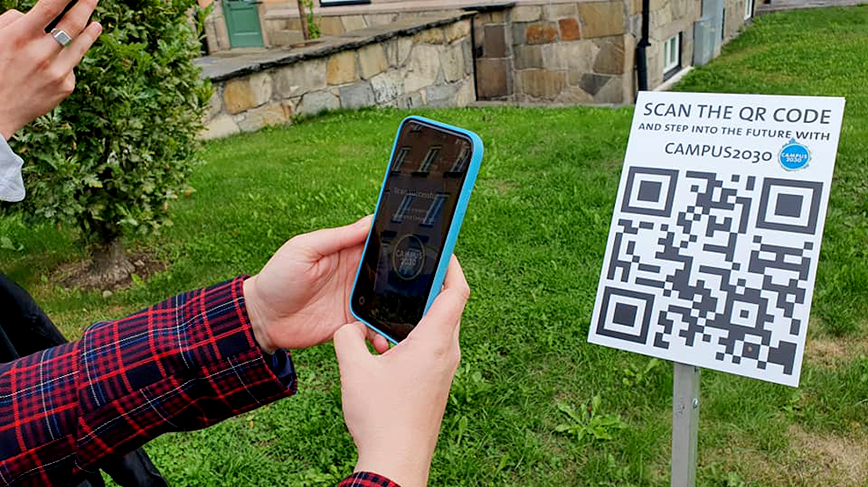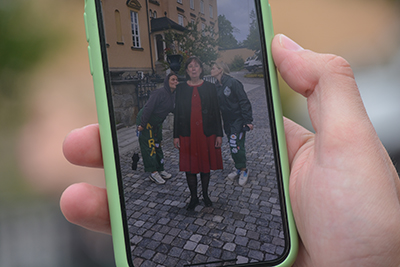Campus2030 is a testbed for sustainable transport solutions

A digital twin of the campus where researchers and students collaborate to test sustainable transport solutions at systems level. An app where the KTH logo shows where you can find various holograms on campus. In late November, the Campus2030 research project is releasing new holograms to persuade more people to engage in the initiative.
If you have passed the KTH House on Brinellvägen, you may have spotted a QR code that you can scan to access the Campus2030 app. You will then see on your screen a digital twin of Campus Valhallavägen that is part of the research project with the same name. An open lab environment where smart transport solutions are being developed for the future.

“When you have the app and scan the QR code, you can see a hologram with one of our use-cases, for example, a self-driving car that KTH has developed. If you touch different parts of the image, you will get different layers of information,” says Nicole Kringos , Professor in Highway Engineering, who is leading the Campus2030 project.
Autonomous vehicles are being developed for the sake of the environment, in order to travel sustainably, she explains. However, if this would lead to greater wear on the asphalt surface at the same time – as the cars would drive on exactly the same part of the road – this would result in increased maintenance requirements. This would mean that gains on the vehicle side would be offset by losses on the infrastructure side.
“But at the same time, we now have an opportunity to use models and sensors that provide information about the situation from the infrastructure side, that says ‘do not drive here, drive a bit to the right or to the left’. This could mean that the stretch of asphalt would last longer, and so result in a saving for the environment,” Kringos says.
The transport system is being studied from several points of view
One problem today is that the transport sector is a bit stuck in its own silos, where some parts are working with vehicles and other parts with infrastructure, she maintains.
“The focus for Campus2030 is to bring these two sides together, take the whole complexity into account and look at the system from several perspectives, model in a digital twin and see if this really makes things better,” Kringos says.
“Our goal is to be able to offer the industry a virtual testbed where you can test technical solutions and see what happens in society, when you scale up the technology. This is something that is lacking today, we all understand that a transition is needed to achieve our sustainability goals, but the way to get there is by no means clear. We therefore need to focus on the process and new common platforms. To reduce risk for the industry and for society, we have a very big need for these kinds of developed testbeds where we can perform tests before we scale everything up in real life.”
If we are to get there, what is needed is a critical mass of expertise in the form of researchers and students that are involved and come up with ideas and questions. And this does not necessarily have to be researchers and students within vehicle technology or infrastructure, they can equally well come from other areas.
They Want to get more people to use the app
The project team is also interested in exploring how augmented reality can be used in linking to this digital twin. Therefore they want as many people as possible to use their app.
“There is a big value in being interdisciplinary, of daring to step outside your own bubble and include other people’s perspectives. At a technology campus such as KTH, there are so many smart people that maybe have been thinking about these problems too, and would be interested in getting involved,” says Kringos.
“Here, we have an opportunity to reach out to people that have possibly never thought about asphalt or transport issues. But they may have some sharp ideas or questions that could be relevant for the project. And they are most welcome to join in and contribute.”
New holograms will be available at the end of November
At the momen the app has around 200 users. To ensure they remain interested and to persuade more people to use the app and contribute with content, the project team develops holograms and then adds them to the app. The holograms are made with a similar technology that was used for the launch of the new ABBA album. But where the ABBA members are represented by avatars, real people are interviewed in the Campus2030 holograms, filmed in front of a green screen. In order to find the holograms you can click the KTH logo in the app.

“It’s a bit like Pokemon Go. We started with a hologram where the President welcomes you to KTH, which we thought was appropriate at the time of the reception for new students this autumn,” says Kringos.
Five new videos have now been recorded and new holograms will be released as soon as they are ready, starting at the end of November.
“The idea is that everyone who has the app will be motivated to keep checking what’s happening and contribute with content. And we hope more researchers and students will download the app.”
Håkan Soold

